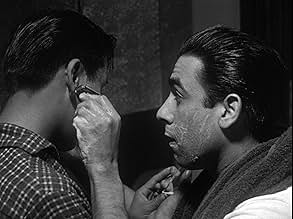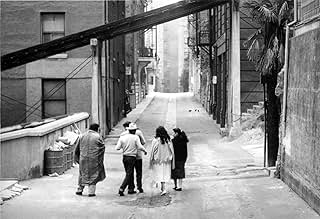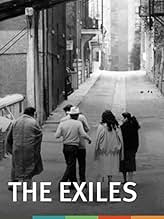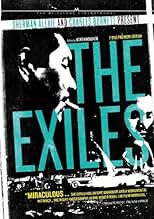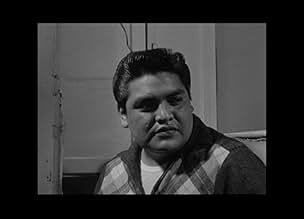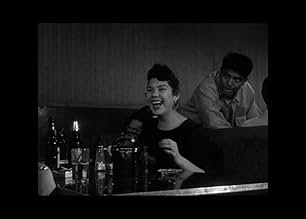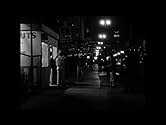IMDb-BEWERTUNG
6,6/10
1511
IHRE BEWERTUNG
Der Film folgt einer Familie von amerikanischen Ureinwohnern, die in der Stadt der Engel leben.Der Film folgt einer Familie von amerikanischen Ureinwohnern, die in der Stadt der Engel leben.Der Film folgt einer Familie von amerikanischen Ureinwohnern, die in der Stadt der Engel leben.
- Auszeichnungen
- 1 wins total
Tom Reynolds
- Tommy
- (as Tommy Reynolds)
Empfohlene Bewertungen
There are some real classics out there but you have to search with information from those who are in the know concerning great films and great filmmakers.
Kent MacKenzie gives us a 24-hour slice of the life of a young couple who moved from the reservation to Los Angeles in the 50s. I can go back and appreciate this now that I am older; much more than I would have at 11.
It is not a pretty picture. The men didn't work and spent their time drinking and gambling and hanging out. The wives were expected to feed them, clean their clothing, and give them what money they had.
There was a real fatalism in their voices and attitudes. Life was a party, and if things didn't work out, you could always go back to the reservation. Doing time? No problem, I do it outside, so I can do it inside.
Added to the National Film Registry this year, it is a slice of life that shows no promise.
Kent MacKenzie gives us a 24-hour slice of the life of a young couple who moved from the reservation to Los Angeles in the 50s. I can go back and appreciate this now that I am older; much more than I would have at 11.
It is not a pretty picture. The men didn't work and spent their time drinking and gambling and hanging out. The wives were expected to feed them, clean their clothing, and give them what money they had.
There was a real fatalism in their voices and attitudes. Life was a party, and if things didn't work out, you could always go back to the reservation. Doing time? No problem, I do it outside, so I can do it inside.
Added to the National Film Registry this year, it is a slice of life that shows no promise.
This is a film that certainly won't appeal to the average person. However, despite this, it is an interesting and important film. The movie began as a school project at USC and eventually resulted in this small-time picture. It's about a group of displaced American-Indians who are living in Los Angelese. Unfortunately, their sense of purpose and work ethic have become lost in the transition from the reservation. This film documents a 24-hour stretch in their rather purposeless lives. As a piece of history and commentary it's very important stuff, though it's also the type stuff that is dreadfully dry. Seeing people going about their lives as you hear voice-overs and see dialog crudely inserted (it almost never matched the lip movements of the characters and was sloppy) becomes a bit of a drag after a while. A noble fictionalized documentary but one for which you really have to have a lot of patience in order to enjoy.
10Mackzee
"The Exiles" was made on a shoe-string budget by a number of idealistic young film-makers "led" by Kent Mackenzie as "writer/director/editor.
Mackenzie and his crew were dismayed (putting it lightly)by what they saw as a lack of use of film as an artistic medium. At the same time the standard "Hollywood" aesthetic sacrificed subject, in order to obtain perfect/yet unrealistic lighting schemes, camera movement, framing and pristine sound tracks.
Erik Daarstad, John Morrill and Bob Kaufman shot an incredibly striking 35mmm B&W film. It is truly stunning. And a testament to all involved.
"The Exiles" is phenomenal in that, Mackenzie agreed not to put anything in the film that "the actors" objected to in any way. Appropriately, but very unusual, the "voice" in the film is that of the subjects.
"The Exiles" is of a specific time: a Los Angeles that literally no longer exists. And it is timeless, in the questions it asks and in it's gut wrenching portrayal of a particular group of individual's lives. Lives that unfortunately could/and do exist as I write this almost 50 years later.
Mackenzie credits the viewer with the intelligence to relate to the human condition as seen on screen. And explore for one's self how we fit into a world in which these conditions exist. We aren't forced to listen to the traditional "voice of god" voice over that dehumanizes all involved in the experience.
Sadly, Kent Mackenzie died young in May of 1980. He made relatively few films. Yet, "The Exiles" and his USC student film: "Bunker Hill" (made with Robert Kaufman) spoke to a bright young artist who worked with an integrity few possess.
If one has the opportunity to see this film as it should be, in a theater on a 35mm print. It is well worth the time. And an experience which will stay with you from that day forward.
Mackenzie and his crew were dismayed (putting it lightly)by what they saw as a lack of use of film as an artistic medium. At the same time the standard "Hollywood" aesthetic sacrificed subject, in order to obtain perfect/yet unrealistic lighting schemes, camera movement, framing and pristine sound tracks.
Erik Daarstad, John Morrill and Bob Kaufman shot an incredibly striking 35mmm B&W film. It is truly stunning. And a testament to all involved.
"The Exiles" is phenomenal in that, Mackenzie agreed not to put anything in the film that "the actors" objected to in any way. Appropriately, but very unusual, the "voice" in the film is that of the subjects.
"The Exiles" is of a specific time: a Los Angeles that literally no longer exists. And it is timeless, in the questions it asks and in it's gut wrenching portrayal of a particular group of individual's lives. Lives that unfortunately could/and do exist as I write this almost 50 years later.
Mackenzie credits the viewer with the intelligence to relate to the human condition as seen on screen. And explore for one's self how we fit into a world in which these conditions exist. We aren't forced to listen to the traditional "voice of god" voice over that dehumanizes all involved in the experience.
Sadly, Kent Mackenzie died young in May of 1980. He made relatively few films. Yet, "The Exiles" and his USC student film: "Bunker Hill" (made with Robert Kaufman) spoke to a bright young artist who worked with an integrity few possess.
If one has the opportunity to see this film as it should be, in a theater on a 35mm print. It is well worth the time. And an experience which will stay with you from that day forward.
A belated attempt at an American neorealism or rather peaceful protest against the chintz and artifice of Hollywood with a document of the down and out who the movies were never about, either way this film about a group of young indians eking out a living in downtown Los Angeles is a rare artifact and an amazing find.
The lives; equal parts mundane and exciting, wearily enthusiastic at the prospect of another night where nothing but time flies and the same people are bolted down in the same bar stools. Beer bottles change hands over cheap formica counters, people dance, look around bored, smile at looking and being looked, saunter and stroll around aimless. During most of this the woman is back in a movie theater catching a late-night show. At some point the lights come up and intermission music plays from the speakers as sleepy patrons stretch and look around with drowsy eyes; it's that kind of movie. The moments no self-respecting Hollywood movie would bore its audience with, here strung up to see what kind of life they make up.
But most importantly, what precious, valuable poem about a Los Angeles that is no more. Not the Los Angeles imagined by Hollywood, the movie version as a fantastical den of iniquity where sultry femme fatales seduced schmucks in Spanish-style mansions. The real deal, where people lived. Cinema verite as it were, purporting the revelation of some truth in turn.
What truth here is all in the image. We can cobble together a view of the historic past but never before the invention of the camera lens did we have the actual thing rich with so much texture and detail, the magical contradiction of living ghosts (people or places).
Come to this not to be a told a story about these people. Ordinary anxieties of the displaced the same as everywhere else, the young and restless with too much time. Come to this to inhabit for a while, to sit around and listen. Compare with what LA we are thrown into 30 years later in Falling Down.
In the extras of the pristine restoration conducted by the UCLA, we find a 1956 student short about Bunker Hill, the neighborhood depicted. It's perhaps even better than the actual film. Interviewed are actual residents as we see footage of day-to-day lives, old men all about to be swept aside with their old world. They like to watch the public works constructed in the area, the ones will eventually push them out.
The lives; equal parts mundane and exciting, wearily enthusiastic at the prospect of another night where nothing but time flies and the same people are bolted down in the same bar stools. Beer bottles change hands over cheap formica counters, people dance, look around bored, smile at looking and being looked, saunter and stroll around aimless. During most of this the woman is back in a movie theater catching a late-night show. At some point the lights come up and intermission music plays from the speakers as sleepy patrons stretch and look around with drowsy eyes; it's that kind of movie. The moments no self-respecting Hollywood movie would bore its audience with, here strung up to see what kind of life they make up.
But most importantly, what precious, valuable poem about a Los Angeles that is no more. Not the Los Angeles imagined by Hollywood, the movie version as a fantastical den of iniquity where sultry femme fatales seduced schmucks in Spanish-style mansions. The real deal, where people lived. Cinema verite as it were, purporting the revelation of some truth in turn.
What truth here is all in the image. We can cobble together a view of the historic past but never before the invention of the camera lens did we have the actual thing rich with so much texture and detail, the magical contradiction of living ghosts (people or places).
Come to this not to be a told a story about these people. Ordinary anxieties of the displaced the same as everywhere else, the young and restless with too much time. Come to this to inhabit for a while, to sit around and listen. Compare with what LA we are thrown into 30 years later in Falling Down.
In the extras of the pristine restoration conducted by the UCLA, we find a 1956 student short about Bunker Hill, the neighborhood depicted. It's perhaps even better than the actual film. Interviewed are actual residents as we see footage of day-to-day lives, old men all about to be swept aside with their old world. They like to watch the public works constructed in the area, the ones will eventually push them out.
Astonishing slice of cinema verite at a time when young filmmakers were trying to break the Hollywood habit in favor of the real world. The 70 minutes are not entertaining; however, they do fascinate. It's a nighttime of boozing carousal for several young Indian men amid the neon jungle of downtown LA. The camera tracks their aimless wanderings and endless drinking from one seedy venue to the next. It's LA like you've seldom seen it—a down-and-outers look at unvarnished urban decay. The faces too are fascinating, not like the usual Hollywood Indian or crowd scene extras.
It's a disturbing look, slow to accumulate until the poignant final shot. These are truly lost people, caught between two incomplete worlds-- the urban jungle of the white man and the captive reservation of the Indian. The men seem to treat most everything as a joke, perhaps a way of denying the dead-end reality of their lives. Ironically, they appear now to be strangers in their own land. It's the young Indian woman Yvonne, however, who's likely to evoke audience sympathy. It's she who dreams (her inner thoughts vocalized in voice-over) of a family and something like a normal life. But, the men in her life are truly lost, so her hopes appear doomed as well. Seeing this document may help viewers better understand the controversial American Indian Movement (AIM) of the 1970's.
Apparently, the project spanned several years of interrupted funding. Thus, the film has to be an artistic commitment of a high order on the part of filmmaker MacKenzie. Did he hope for a commercial release. A story and technique like this would seem to hold little promise of that. Did he hope for art house distribution and an appeal to the intelligentsia. Whatever the motivation, he's produced a document of lasting social value, and thanks be to TMC for bringing MacKenzie's achievement to today's audiences
It's a disturbing look, slow to accumulate until the poignant final shot. These are truly lost people, caught between two incomplete worlds-- the urban jungle of the white man and the captive reservation of the Indian. The men seem to treat most everything as a joke, perhaps a way of denying the dead-end reality of their lives. Ironically, they appear now to be strangers in their own land. It's the young Indian woman Yvonne, however, who's likely to evoke audience sympathy. It's she who dreams (her inner thoughts vocalized in voice-over) of a family and something like a normal life. But, the men in her life are truly lost, so her hopes appear doomed as well. Seeing this document may help viewers better understand the controversial American Indian Movement (AIM) of the 1970's.
Apparently, the project spanned several years of interrupted funding. Thus, the film has to be an artistic commitment of a high order on the part of filmmaker MacKenzie. Did he hope for a commercial release. A story and technique like this would seem to hold little promise of that. Did he hope for art house distribution and an appeal to the intelligentsia. Whatever the motivation, he's produced a document of lasting social value, and thanks be to TMC for bringing MacKenzie's achievement to today's audiences
Wusstest du schon
- WissenswertesKent Mackenzie borrowed equipment from industrial film makers Parthenon Pictures and used the unused "ends" of thousand-foot reels of 35mm film, according to an article in the 12 March 1961 edition of the New York Times.
- PatzerIn a scene where an older man is heard singing and playing an instrument under a tree, he is not doing corresponding actions in a long-shot.
- VerbindungenFeatured in Los Angeles Plays Itself (2003)
Top-Auswahl
Melde dich zum Bewerten an und greife auf die Watchlist für personalisierte Empfehlungen zu.
- How long is The Exiles?Powered by Alexa
Details
- Erscheinungsdatum
- Herkunftsland
- Offizieller Standort
- Sprache
- Auch bekannt als
- Изгнанники
- Drehorte
- Weitere beteiligte Unternehmen bei IMDbPro anzeigen
Box Office
- Budget
- 539 $ (geschätzt)
- Bruttoertrag in den USA und Kanada
- 30.945 $
- Eröffnungswochenende in den USA und in Kanada
- 8.448 $
- 13. Juli 2008
- Weltweiter Bruttoertrag
- 30.945 $
- Laufzeit
- 1 Std. 12 Min.(72 min)
- Farbe
- Sound-Mix
- Seitenverhältnis
- 1.37 : 1
Zu dieser Seite beitragen
Bearbeitung vorschlagen oder fehlenden Inhalt hinzufügen


